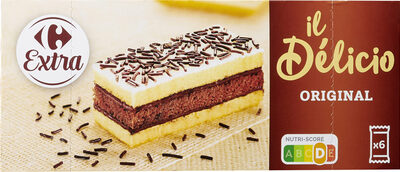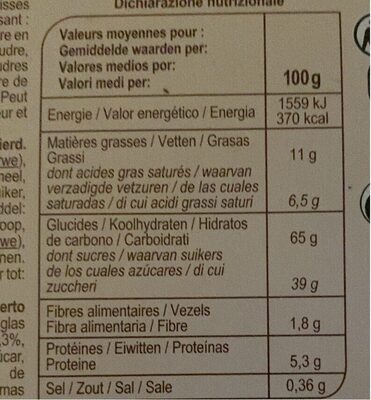il Délicio Original - Carrefour - 182 g
This product page is not complete. You can help to complete it by editing it and adding more data from the photos we have, or by taking more photos using the app for Android or iPhone/iPad. Thank you!
×
Some of the data for this product has been provided directly by the manufacturer Carrefour.
Barcode: 3560071260156 (EAN / EAN-13)
Common name: Génoises avec fourrage (18,3%) goût chocolat, nappées et décorées.
Quantity: 182 g
Brands: Carrefour
Categories: Snacks, Desserts, Sweet snacks, Biscuits and cakes, Cakes, Filled sponge cake slices
Labels, certifications, awards:
Green Dot, Nutriscore, Nutriscore Grade D
Producer: Fabriqué par Bouvard Italia S.p.A, Via N. Nigris, 26 - 33034 Fagagna (UD) – Italie.
Stores: Carrefour, carrefour.fr
Matching with your preferences
Environment
Packaging
Transportation
Threatened species
Other information
Conservation conditions: A conserver à l'abri de la chaleur et de l'humidité. Pour une dégustation optimale, à consommer de préférence avant le / N° de lot : voir sur le côté de l'étui.
Customer service: Interdis - TSA 91431 - 91343 MASSY Cedex - France
Report a problem
Data sources
Product added on by kiliweb
Last edit of product page on by org-carrefour.
Product page also edited by charlesnepote, driveoff, ecoscore-impact-estimator, moon-rabbit, openfoodfacts-contributors, quechoisir, roboto-app, spotter, stive24, teolemon, vaporous, yuka.Xa9pLNDaDsp9LPHZ_7wu2TfkNP79OdldMVAhow, yuka.sY2b0xO6T85zoF3NwEKvlhZ1DfbF-irFDU3mvmyM_9DSDJ7VRf1Y7broCKs, yuka.sY2b0xO6T85zoF3NwEKvlkBkWYD1nBDOMgHWmFfWwvWvKZXpUNxq5bbTb6o, yuka.sY2b0xO6T85zoF3NwEKvll5fU4DVjC3NNgThl1XW14i-coe3Q4pU-Jjab6s, yuka.sY2b0xO6T85zoF3NwEKvllZ4Q93DoRv2ECXUt1-v9o-TKJfpSshY7oPCGao, yuka.sY2b0xO6T85zoF3NwEKvlmZJCtOAvjXFFDrup2uZ7PCoErGzWfhW-dfWE6s, yuka.sY2b0xO6T85zoF3NwEKvlnUdfPrZqx-aN0LvpnSxn4uiErrIQ8lg-9TBaas.










